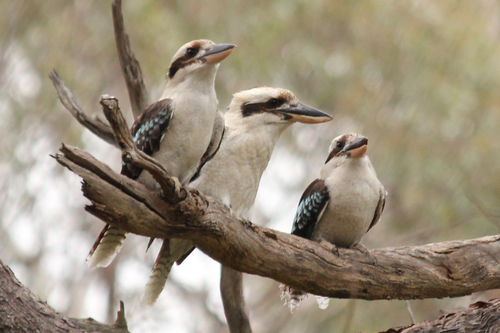
Laughing Kookaburra
The Laughing Kookaburra (*Dacelo novaeguineae*) is an iconic Australian bird, instantly recognizable by its distinctive call that resembles boisterous human laughter. It is the largest member of the kingfisher family and plays a significant ecological role as a top predator in its environment, controlling populations of insects, small reptiles, and rodents. Culturally, the Kookaburra is a prominent figure in Australian folklore and is often associated with the bush and outback, symbolizing the spirit and resilience of the Australian landscape.
40-47 cm
Length
60-80 cm
Wingspan
Least Concern
Conservation Status
Distribution
Native to eastern Australia, ranging from Queensland to South Australia and Victoria. Introduced to Western Australia, Tasmania, and Flinders Island. They have also been introduced to New Zealand.
Lifespan
Up to 20 years in the wild; potentially longer in captivity.
Laughing Kookaburra's Habitat
Habitat Types
Eucalyptus forests, Woodlands, Open savannas, Urban parks and gardens
Climate Zones
Temperate, Subtropical
Adaptations
Kookaburras are highly adaptable to a range of habitats, thriving in both natural and human-modified environments. They are tolerant of a degree of habitat disturbance, provided there are sufficient trees for nesting and perching.
Variations
Two subspecies are generally recognized, *D. n. novaeguineae* (eastern Australia) and *D. n. minor* (Cape York Peninsula), with the latter being slightly smaller.
Appearance
Breeding Plumage
No significant difference between breeding and non-breeding plumage.
Seasonal Feather Changes
Minimal seasonal variation.
Sex Based Plumage Differences
Males may have slightly more blue on the wings and rump, but this is often subtle.
Notable Features
Large, heavy bill, Brown and white mottled plumage, Dark brown eye stripe, Stout body with a large head
Diet and Feeding
Primary Foods
Insects, Small reptiles (lizards, snakes), Small mammals (rodents), Crustaceans, Frogs, Occasionally small birds
Foraging Behavior
Kookaburras are 'sit-and-wait' predators, perching on branches and scanning the ground for prey. Once prey is spotted, they swoop down and capture it with their powerful bill.
Specializations
Their strong bill is adapted for killing and consuming a variety of prey, including venomous snakes. They often bash larger prey against a hard surface before swallowing it.
Seasonal Diet Variations
Diet may shift slightly depending on prey availability, with more insects consumed during warmer months and potentially more small vertebrates during cooler periods.
Behavior
Social Structure
Kookaburras live in family groups, often consisting of a breeding pair and several helper birds (usually offspring from previous years).
Communication
Loud, laughing call used for territorial defense and communication within the family group, Various other calls, including soft trills and chuckles
Migration
Kookaburras are non-migratory, remaining in their territories year-round.
Territorial or Group Behaviors
Family groups are highly territorial, defending their area against intruders with loud vocalizations and aggressive displays. Communal roosting occurs within the family territory.
Conservation
Threats
Habitat loss and degradation (particularly loss of mature trees with hollows), Secondary poisoning (from pesticides or rodenticides), Competition with introduced species (e.g., Common Myna), Road mortality
Protection Programs
Habitat preservation and restoration initiatives, Public awareness campaigns promoting responsible pesticide use
Local National Laws
Protected under state and national legislation in Australia (e.g., National Parks and Wildlife Act).
Population Trend
Stable
Population Estimates
Although widespread, precise population estimates are difficult to obtain. The global population is considered large and not currently threatened.
Interesting Facts
The Kookaburra's 'laugh' is actually a territorial call.
It serves to advertise the boundaries of their territory and warn off rivals.
Kookaburras are known to kill and eat venomous snakes.
They are remarkably skilled at handling snakes, often bashing them against a branch to subdue them.
They are cooperative breeders.
Young Kookaburras often stay with their parents for several years, helping to raise subsequent broods.
Kookaburras have been introduced to other parts of Australia and the world.
These introductions have sometimes had negative impacts on local ecosystems.
Faqs about Laughing Kookaburra
What should I do if I find an injured Kookaburra?
Contact a local wildlife rescue organization or veterinarian. Do not attempt to handle the bird yourself, as they have strong beaks and sharp claws. *Consult a professional for expert advice.*
Are Kookaburras aggressive towards humans?
Kookaburras are generally not aggressive towards humans unless they feel threatened or their nest is approached. It's best to observe them from a respectful distance.
Do Kookaburras mate for life?
Kookaburras typically form strong pair bonds that can last for many years, often for life. However, if one partner dies, the surviving bird may find a new mate.
Why do Kookaburras laugh at dawn and dusk?
The dawn and dusk chorus is thought to be a way of reinforcing territorial boundaries and strengthening social bonds within the family group.
Copyright @ Nature Style Limited. All Rights Reserved.
 English
English